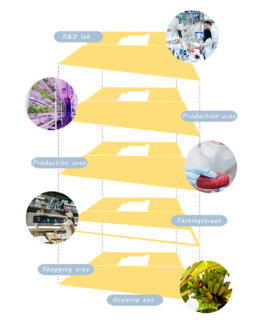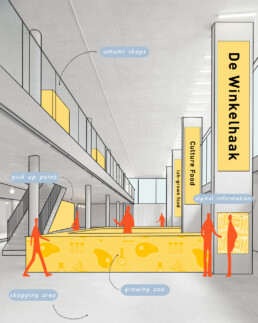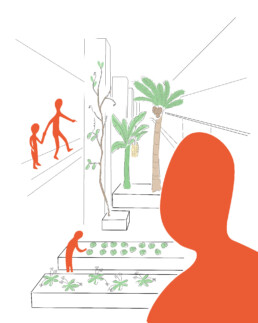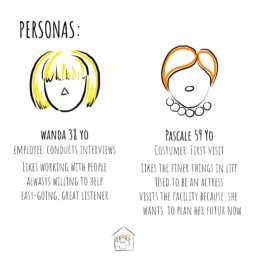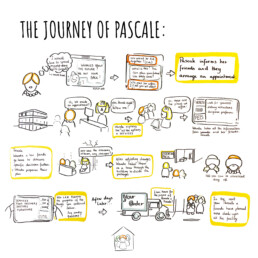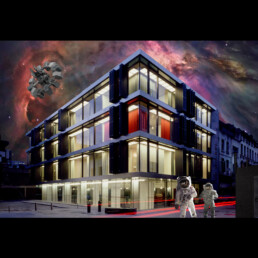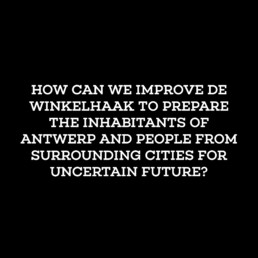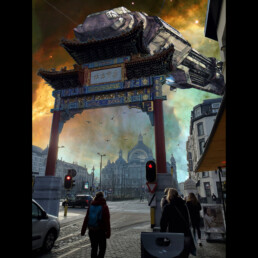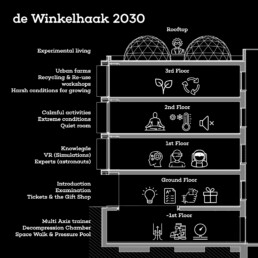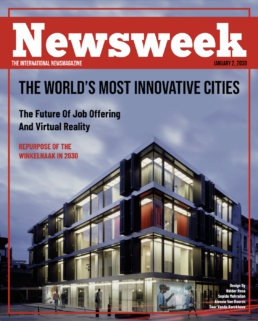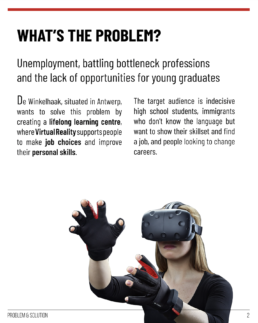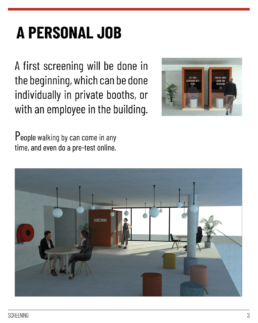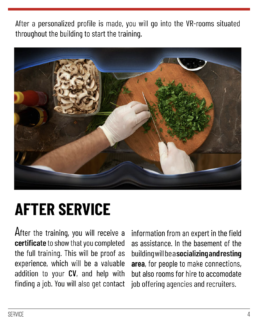What could the De Winkelhaak be in 2030?
This was the challenging question our Space and Service Design students got asked by Klara De Smedt, Director at De Winkelhaak during a workshop at the co-working powerhouse.
De Winkelhaak in Antwerp, also known as House of C, is a collective building for creative entrepreneurship which offers customised co-working for start-ups to grow into ambitious companies. In addition to offices, meeting rooms and services for innovative entrepreneurs, they currently also offer a design gallery and an event or presentation space. Located close to Antwerp Central station it’s now placed in the centre of a growing creative community, but this wasn’t always the case.
Before there was any talk about De Winkelhaak, the neighbourhood it resides in now was dominated by prostitution, crime and drug use. After the drawing up and approval of a structural sketch for the station area in 1993-1994 and thanks to the European funds from the Urban program, Mayor Leona Detiège and her colleague had enough scope from 1999 to ban prostitution from the neighbourhood, revitalising the streets. These changes fuelled the start of an ambitious property policy, after which a needs assessment was done and the concept of De Winkelhaak as we know it today was born.
Now, 20 years later, it’s time to think re-think the future of this building again, as the building will be transferred to the City of Antwerp by 2030. For this challenge, our students placed their visionary minds together and came up with different future proposals. Discover the solutions they came up with below.
The first proposal “hyper local food hub” is by Mira Claessens, Olivier Van Hamme, Pjotr Vandierendonck and Reinout Van der Hauwert
Antwerp, Summer 2030. Belgium has been hit by a drought for a tenth consecutive year. Extreme weather has made large scale agriculture impossible.
Animal Farming has been outlawed freeing up land to grow crops for humans instead of cattle. Water scarcity has transformed our meat based diet overnight. Recipes that have been passed on for decades are very hard to replicate simply because the ingredients are no longer around. If not for Culture Food, the younger generation would have lost the food sensations and flavours that once defined our Culture. Culture Food originally started as a Design Center known as the Winkelhaak. It was a very different time back then, in 2001. The Winkelhaak has transformed to a hyper local food hub in Antwerp midway the roaring twenties. The food hub offers ingredients that have grown extinct over the years because of the ongoing Climate Crisis. Culture Food disconnects Food Production from Agriculture.
Everything is produced in and around the supermarket which in itself is part of a food hub. The food offerings are determined by the cuisine of the different cultures in the neighbourhood. Down in the basement there is the supermarket. The Umami street on the ground floor traverses the building drawing the locals in with food stalls where you can taste bite sized freshly made street food.
The first and second floor are reserved for growing meat, spices, and herbs. The meat is lab grown from animal cells. On the top floor, PhD students work with food designers and service designers to help safeguarding the endangered Food system.
The second proposal called “The Future Hub” was created by Amber De Coen, Carol Sakayan, Gilles Verset and Lukas Van Looy.
The government wants people to live at home for as long as possible. This gives people more freedom, but also more things to arrange and plan for their future. This is where “The Future Hub” comes to the rescue. One place, one goal. We keep you at home, comfortable and surrounded by the people and the things that you love. For as long as possible.
But what exactly do we offer? We offer you a service that looks for the perfect people to co-house with, to fill up your home again. And when the kids are out of the house we will look for a new companion for you (one that might bark). Sharing is so important, this is why we want to encourage you to share your working experiences and talents with the new generation, and thus contribute to improving the future of others. We offer you the most comfortable furniture, perfectly tailored to your lifestyle and needs. And when you need them the most, we put you in touch with the right experts. Is going to the grocery store becoming too much of a hassle? Our specialists will make sure you get the perfect ingredients for you to thrive.
But how is this idea future proof? By having a research team on board, the Future Hub will always be on top of all the new trends and needs, making sure that you always get the best, newest and finest products or services the market has to offer.
After learning all of this, are you still worried about your future? Don’t worry we got your back!
The next proposal was a training centre created by Kimberly Vonckx, Sevdenur Dursun, Andrej Arnaudovski and Daria Danilchenko.
A wise man once said: “Two possibilities exist: either we are alone in the Universe or we are not. Both are equally terrifying.” – Arthur C. Clarke.
What do we actually know about the future? Very little. However, that doesn’t stop us from imagining what will happen in the upcoming decades. One thing is certain, we better be prepared for possible future events. Having this mindset, we envision that in 2030 the Winkelhaak in Antwerp will transform into a Training Center. Not only to prepare citizens for uncertain future events on planet Earth, but also in outer space.
We want people to be ahead of time and prepared, both physically and mentally, so they learn how to be resilient, courageous and self-aware. Locals and visitors from surrounding areas will have the opportunity to take part in various activities and challenges. They could be having a spacewalk in the pressure pool, take a seat in the multi-axis trainer, do a VR simulation or find themselves in the vacuum chamber which will imitate the feeling of what it is really like to be in space, while being supervised and lectured by retired astronauts. Passers-by will stop and take a moment to grasp what is happening inside, because of the big windows. For those who are intrigued and motivated, we offer the chance to experience a month in our space domes on the rooftop. These domes are limited with food, water and no contact with the outside world and are a representation of being inside a spacecraft. Furthermore, the Winkelhaak will have a designated floor to help citizens develop resilience to outbreaks such as diseases and viruses. Another floor will teach them how to grow plants under harsh conditions.
In conclusion, with this facility we are one step ahead of being ready for almost any future event.
The final proposal called “LIFELONG LEARNING” was made by Alessia van Dooren, Hélder Rose, Saar Vande Kerckhove en Sepide Mehralian.
In 2030, lifelong learning will be one of the most important challenges in the world. With this in mind, we propose the facilities of De Winkelhaak in Antwerp to be reconfigured into an educational training centre to revolutionise the learning process and to be worthy of being on the cover of Newsweek magazine once again.
Highly focused on VR, this facility will allow its users to become more enlightened in their future career choices or their professional future. In De Winkelhaak, students who are indecisive about their academic path, immigrants, who don’t know the language but want to show their skillset or people looking to change careers, can be submitted to a personal screening to register their preferences.
Then, they will be advised to try some VR experiences where they will be able to see if one of those is the path they want to follow, to have some training from 1 day to a week, and even make companies more likely to hire them by obtaining a certificate for their CV. All users will have access to a network of coaches and advisors afterwards, which will provide direction and advice in their future careers.
The facility will have different roles for each floor. The basement will be for social activities and bottleneck jobs offices where companies will pay for a specific job to be portrayed, trained and displayed to passers-by. The ground floor will be for the reception and screening of the users. Then the first floor will be focused on primary and secondary job sectors (farming, manufacturing). The second floor will be for the tertiary sector (teaching, law) and the third floor will be destined for the quaternary sector (IT, R&D). With this, we hope to help revolutionise the job finding and learning sectors in 2030.


